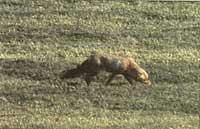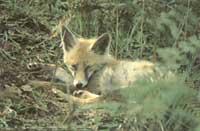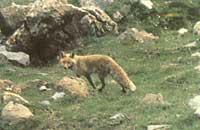The fox, master of atrocities

It is the most famous and known of mammals. Its cunning and reflexivity, and its ability to adapt to different situations, have made the fox (Vulpes vulpes vulpes vulpes) the protagonist of numerous stories, poems, songs, etc., becoming a privileged place among the beasts of the northern hemisphere. The skill and skill of this animal have a special mention in all the cultures of our environment, and surely there are no children or adults who do not know the appearance and customs of the fox.
However, and although it has frequently appeared to us in photographs and drawings, films or videos, we will cite its main characteristics. The fox is tired, so its general appearance is that of a small dog: the length of the head and body is usually 70-80 cm and that of the isata of 50-60 cm, being able to weigh 6-8 kg. The head is elongated and normally carries sharp ears upright. Bright orange eyes. Sweet skin consists of two types of hairs, some short and smooth, which form a protective layer of the cold animal.

The rest, longer and more resistant, form a coat of color visible from the outside. The fur varies according to the time of year and although in winter it is long and compact, in summer it is usually short and thin, giving the animal a more slender appearance. The fox has long and strong legs that allow him to travel a long way every day. The colouring can be very variable, but on the top predominate reddish brown tones, although you can also see grey or yellow specimens. The bottom is skirt, chest and belly, whitish or light gray.
The hairy tail that carries on its end adorned with white wicks is very useful, both as a defensive instrument, both in its struggles for the protection of the territory and in the form of a coat, to collect the body when resting in the winter colds, and to use it as a slogan of balance when it goes in fast or in progress.
In general, the appearance of the fox, its movements, show the slenderness, and when it goes up and down the mountain it seems that more than walking it slips like a snake. Despite being usual at night, also during the day you can see that it explores the corners that it considers dependent. And the fox is a territorial animal, but not too demanding in these matters, and except in breeding season its limits can be very variable. Moreover, males accept females in their territories.

Like dogs, foxes use odorous signals to establish the limits of their territory; these signals are deposited in showy and remarkable places such as fences, rocks or unique trees, concrete mixers, etc., as well as in the hedgehogs, on which, making pix, leave mobile signs, since the hedgehog is also a territorialized animal.
As we have said, the fox is above all a nocturnal animal, which throws the day lying under a scrub, in some backyard of trees or anywhere else. At dusk, he leaves the shelter and comes to drink to a river to find food: it is time for hunting. The fox constantly explores all areas of his territory, making a constant round; exploring paths, stones, holes, brambles, and every corner, he discovers everything that happens in his place of residence. Although depending on the denture has been classified in the group of carnivores, the fox also eats others, and in his diet are included all kinds of fruits: hazelnuts, chestnuts, acorns, beech, cherries, blueberries, mazustas, strawberries, endrinas, etc.
However, it is a great hunter whose prey includes from insects to roe deer or sarrio. However, mice, satysos and other micromammals are their most normal hunting pieces. It is also dedicated to hare, rabbit, marmot and partridge, and also benefits from the theft of nests, which captures eggs and chickens of birds that drown on the ground. Likewise, in the reeds of lakes and marshes he dares to take some of the palmipedas that nests there. In summer he eats mainly insects, reptiles and mice. Finally, it does not oppose the massacre or other food waste, so today it has also adapted to landfills.

The fox's march is fast and naughty and has great ability to move dragging, touching almost with the belly the ground. In addition, it is a great runner and can make big jumps if you have to escape the danger. On the other hand, it makes a lot of sense, with the ear being the most developed. The smell is also comparable to that of a hunting dog, but his vision is not so strict, he only sees it in the whisper and like most mammals.
The zeal begins towards the month of January, when there are struggles between males for the territory and females. On the cold nights of this station you can often hear special strong barking.
The first job at the time the couple is formed will be to chase away the rest of foxes present in their territory. Throughout the gestation, 62 days long, the female explores all the holes in the area, repairing and adapting the most suitable. In the hole you will choose at the last moment, it will consist of 3 to 6 grains, and when these have 4 weeks, the eyes will open and will approach the pit. At this time the male will be responsible for family feeding and will have to go hunting often. Meanwhile, the female is in charge of giving the breasts to the young and taking care of the surroundings of the hole. When he has to raise his young, the fox becomes extremely daring; the male attacks chickens and the like to meet the needs of the family, and the female is also able to confront the man to defend the young that are in the hole.

In these cases, and in case of any danger, the female takes the offspring and carries them individually to another hole. The Azerikume are tremendously playful children who, as soon as possible, will study every corner of the area, always under the strict custody of their mother. To turn three months they will go hunting with their parents and they will have to learn quickly, since when autumn comes the family disperses. However, young people will remain in or around their parents' territory.
The fox lives all over Europe, except in Iceland and the Arctic Islands. In Euskal Herria you can find it all over the territory, from the sea level to the Pyrenees, in the arid lands of the Bardenas and in the jungle of Irati, or in the marshes of Urdaibai, as well as in the landfills of the area of Bilbao, where it feeds on waste and rodents that reproduce at its coast. It is a Vikist species capable of adapting to any type of habitat and with a high degree of fertility. It is not surprising, therefore, that the fox is the most abundant carnivore in the Basque Country.
The fox has only natural enemies. And the wolf has disappeared in our country and the royal eagle is already very scarce. Consequently, man is the only enemy left to this animal, but not anyone. Man has always yielded to the fox; mainly by aggression to the cattle, by considering it harmful to other species, or simply by wanting to seize his beautiful skin.

II. However, after the World War the fourth reason why the fox was a transmitter of hydrophobia emerged. Since then there have been numerous attempts to control the population of this animal throughout Europe, but it cannot be said that they have been very successful, since the fox counterposes to attacks high fertility and adaptability to any habitat. And thank you! We have a great controller of the rodents foxes, and their present abundance is a consequence of the ecological imbalance that we ourselves have created.
Technical information Common fox |
SPECIES: Vulpes vulpes |





